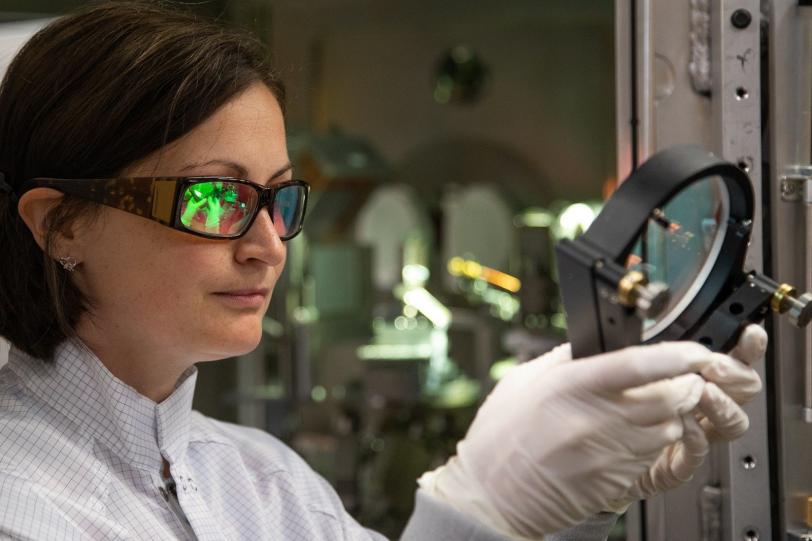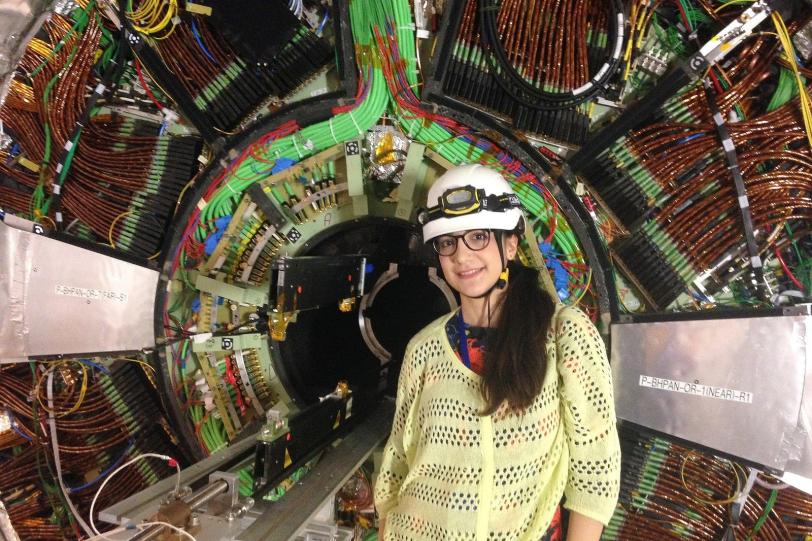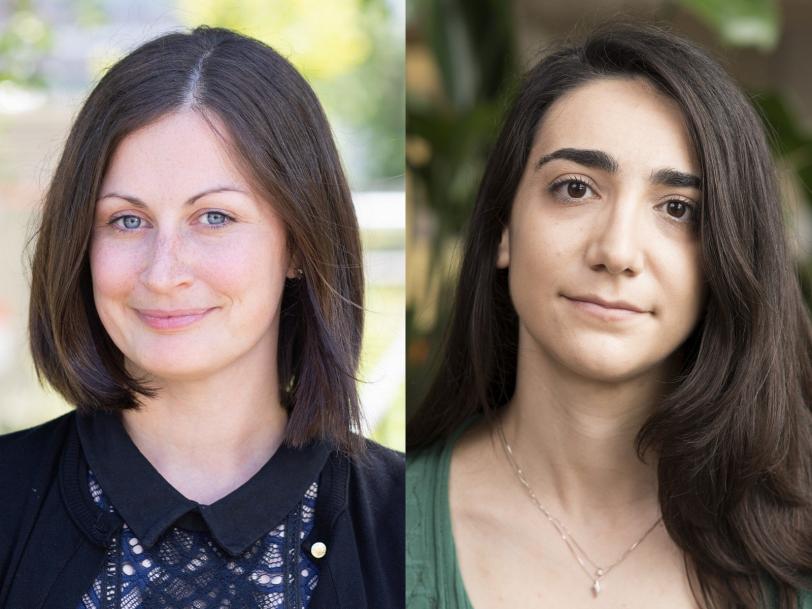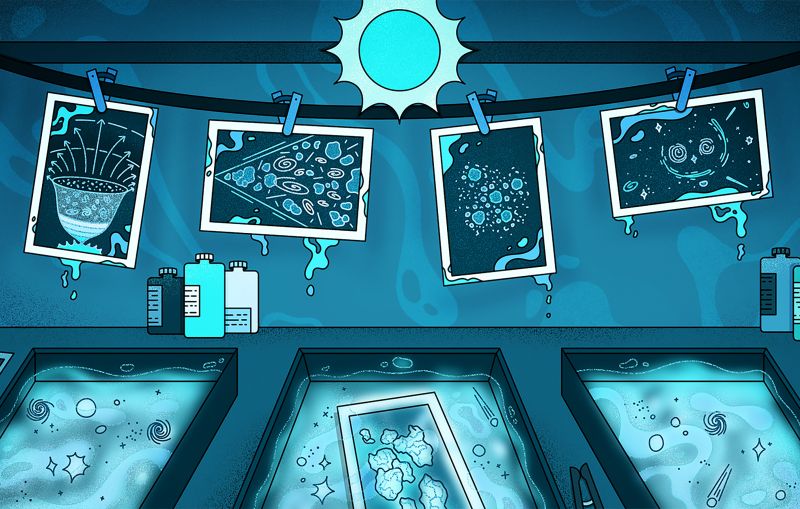Emma McBride and Caterina Vernieri Receive 2018 Panofsky Fellowships at SLAC
Their work will deepen our understanding of matter in extreme conditions and fundamental particle physics.
By Manuel Gnida
Emma McBride and Caterina Vernieri are the recipients of this year’s Panofsky Fellowships at the Department of Energy’s SLAC National Accelerator Laboratory. McBride will develop techniques to study matter in extreme conditions like the ones inside planets and stars. Vernieri will continue her research on the Higgs boson and its interactions with other elementary particles, which could lead to the discovery of new phenomena on nature’s most fundamental level.
The Panofsky Fellowship, named after SLAC’s founder and first director Wolfgang K. H. “Pief” Panofsky, recognizes exceptional early-career scientists who would most benefit from the opportunity to do their research at the lab. Fellows are appointed for five years, receive generous research funding and are eligible for continuing appointment at SLAC.

Emma McBride: Matter in Extreme Conditions
In many parts of the universe, conditions are much harsher than the ones we’re used to. High pressures and temperatures inside planets create materials in forms that don’t exist anywhere else; even more extreme conditions inside stars enable nuclear fusion, which could provide cheap and clean energy if successfully replicated on Earth; and collisions of celestial bodies generate powerful shock waves that affect how planets form and evolve.
McBride will use SLAC’s Linac Coherent Light Source (LCLS) X-ray laser, a DOE Office of Science user facility, to study conditions like these in the lab. At the Matter in Extreme Conditions (MEC) instrument, she’ll bombard materials with intense light from a high-power laser, setting off shock waves that heat and compress the material. Then she’ll use LCLS’s ultrabright X-ray flashes to observe how the material’s properties change on an atomic level.
Although LCLS has only been around for a few years, it has already revolutionized the field of X-ray science through studies that were not possible before. “The really exciting thing is that whenever you do an experiment at LCLS, you might be the first person to see a new phenomenon or material state,” McBride says.
As a Panofsky fellow, she’ll dive deeper into work she began during her Peter Paul Ewald Fellowship at SLAC and the European XFEL in Germany. That research demonstrated a new configuration for experiments at MEC, in which the shock waves and X-ray pulses go through a material in perpendicular directions rather than in the same direction. This geometry reveals more details of shock-induced effects, such as melting and changes in elasticity.
McBride also plans to implement a novel pulse scheme, developed by SLAC accelerator physicists for LCLS, in which each “shot” of the X-ray laser contains a train of four X-ray pulses instead of just one, opening up new ways of filming materials as shock waves pass through them.
McBride says she’s looking forward to experiments at LCLS-II, an upgrade to LCLS currently underway that will produce even more powerful X-ray beams and allow studies on samples that are not accessible today.
“Some of the technologies available at LCLS are truly unique,” she says. “I also really like SLAC’s outstanding research culture and am excited to have the chance to hire a postdoc.”
Before being named a Peter Paul Ewald fellow, McBride was a postdoctoral research fellow at the German research center DESY. She completed her master’s degree and PhD at the University of Edinburgh, UK.
"We're fortunate that Emma has joined us at SLAC. She has been at the forefront of studying matter in extreme conditions using X-ray pulses with the highest photon energy, bandwidth and repetition rate," says Siegfried Glenzer, head of the lab's High Energy Density Science Division. "She is poised to push the envelope of X-ray laser experiments and mentor young scientists."

Caterina Vernieri: The Higgs Boson and Beyond
Why do things in nature happen the way they do, and how exactly do they happen on the most fundamental level? Those are the types of questions Caterina Vernieri wants to answer with her research in particle physics – an interest that was sparked when she was an undergraduate student in physics and spent a summer at DOE’s Fermi National Accelerator Laboratory.
A few years later, while she was a graduate student working with the CMS collaboration at the Large Hadron Collider (LHC) in Europe, her interest got another boost: The CMS and ATLAS experiments found a bump in LHC data that turned out to be the Higgs boson, a particle associated with the process that gives mass to elementary particles.
There’s still a lot researchers don’t know about the Higgs boson, Vernieri says, explaining her continued fascination with the particle. In her most recent position as a research associate at Fermilab, Vernieri led a group that studied how the highly unstable and short-lived Higgs decays into a pair of fundamental particles known as bottom quarks.
“This favored decay mode of the Higgs boson allows us to study the particle’s properties in great detail and check whether or not they match our theoretical predictions. If they don’t, it would leave room for the discovery of new physics,” Vernieri says. Since the LHC also produces a lot of bottom quarks in other processes, finding this particular Higgs signature is like finding a needle in a haystack. Vernieri pioneered the development of a computer algorithm to identify bottom quarks from Higgs decays.
She was also involved in R&D work for the CMS pixel detector – the detector component closest to the point where particles collide – in preparation for a future LHC upgrade, which will multiply the rate of collisions and produce 10 times more data. As a Panofsky fellow, Vernieri will do similar detector work for ATLAS, on top of pursuing her research interests in Higgs physics.
“How well we can determine the Higgs boson’s properties depends on the quality of the data we collect, and the performance of the pixel detector is a big part of that.” Vernieri says. “I’m very excited about taking on a leading role in the upgrade of the ATLAS pixel detector and about working with wonderful colleagues at SLAC.”
Dong Su, head of SLAC’s ATLAS group, says, “Caterina is one of the top junior faculty candidates from the collider community this year. As a physicist with many talents and interests, she’s a great match for our research program, and we’re very happy that she’s coming here.”
Vernieri, who holds bachelor and master’s degrees from the University of Pisa, Italy, and a PhD from the Scuola Normale Superiore, also in Pisa, is convinced that the Panofsky fellowship is an important next step in her career. It’s a unique opportunity, she says, to build her physics research plan and do great science while being embedded in a large science collaboration whose members pursue a common goal: to learn more and more about how the world ticks on the subatomic level.
For questions or comments, contact the SLAC Office of Communications at communications@slac.stanford.edu.
SLAC is a multi-program laboratory exploring frontier questions in photon science, astrophysics, particle physics and accelerator research. Located in Menlo Park, Calif., SLAC is operated by Stanford University for the U.S. Department of Energy's Office of Science.
SLAC National Accelerator Laboratory is supported by the Office of Science of the U.S. Department of Energy. The Office of Science is the single largest supporter of basic research in the physical sciences in the United States, and is working to address some of the most pressing challenges of our time. For more information, please visit science.energy.gov.






